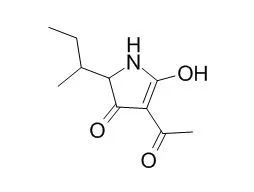| Description: |
Tenuazonic acid, an active component in the A. alternata toxin.Tenuazonic acid exhibits a strong inhibition in photosystem II (PSII) activity, it causes cell necrosis of host-plants by oxidative damage from chloroplast-mediated ROS eruption, and enhances the plant's resistances against rose aphids.
|
| Targets: |
ATPase | ROS |
| In vitro: |
| J Zhejiang Univ Sci B. 2015 Apr;16(4):264-74. | | Alternaria toxin-induced resistance in rose plants against rose aphid (Macrosiphum rosivorum): effect of tenuazonic acid.[Pubmed: 25845360] | Many different types of toxins are produced by the fungus, Alternaria alternata (Fr.) Keissler. Little is known, however, regarding the influence of these toxins on insects.
METHODS AND RESULTS:
In this study, we investigated the toxin-induced inhibitory effects of the toxin produced by A. alternata on the rose aphid, Macrosiphum rosivorum, when the toxin was applied to leaves of the rose, Rosa chinensis. The results demonstrated that the purified crude toxin was non-harmful to rose plants and rose aphids, but had an intensive inhibitory effect on the multiplication of aphids. The inhibitory index against rose aphids reached 87.99% when rose plants were sprayed with the toxin solution at a low concentration. Further results from bioassays with aphids and high performance liquid chromatography (HPLC) analyses demonstrated that Tenuazonic acid (TeA) was one of the most important resistance-related active components in the crude toxin. The content of TeA was 0.1199% in the crude toxin under the HPLC method. Similar to the crude toxin, the inhibitory index of pure TeA reached 83.60% 15 d after the rose plants were sprayed with pure TeA solution at the lower concentration of 0.060 μg/ml, while the contents of residual TeA on the surface and in the inner portion of the rose plants were only 0.04 and 0.00 ng/g fresh weight of TeA-treated rose twigs, respectively, 7 d after the treatment.
CONCLUSIONS:
Our results show that TeA, an active component in the A. alternata toxin, can induce the indirect plant-mediated responses in rose plants to intensively enhance the plant's resistances against rose aphids, and the results are very helpful to understand the plant-mediated interaction between fungi and insects on their shared host plants. |
|
| In vivo: |
| Anal Bioanal Chem. 2013 May;405(12):4149-58. | | Determination of tenuazonic acid in human urine by means of a stable isotope dilution assay.[Pubmed: 23397093] |
METHODS AND RESULTS:
The content of Tenuazonic acid in human urine was determined by a stable isotope dilution assay (SIDA) that was recently developed for the analysis of food commodities and extensively re-validated for urine matrix in this study. Linearity of the response curve was proven between molar ratios n(labeled standard)/n(analyte) of 0.02-100. The limits of detection and determination were 0.2 and 0.6 μg/L, respectively. The mean recovery of the stable isotope dilution assay was 102 ± 3 % in the range between 1.0 and 100 μg/L. Interassay precision was 6.7 % (relative standard deviation of three triplicate analyses of a human urine sample during 3 weeks). The method was applied to two studies dealing with urinary excretion of Tenuazonic acid: In the first study, Tenuazonic acid was quantified in the 24-h urine of six volunteers from Germany (three female, three male) in a concentration range of 1.3-17.3 μg/L or 2.3-10.3 ng/mg(-1) creatinine, respectively. In the second study, two volunteers (one female, one male) ingested 30 μg Tenuazonic acid by consumption of naturally contaminated whole meal sorghum infant cereals and tomato juice, respectively. The urinary excretion of the ingested Tenuazonic acid was 54-81 % after 6 h, depending on matrix and volunteer. After 24 h, 87-93 % of the ingested amount of Tenuazonic acid was excreted, but the fate of the remaining about 10 % is open.
CONCLUSIONS:
Thus, it is not possible to exclude potential health hazards for the consumer, completely.
| | Plant Physiol Biochem. 2014 Nov;84:10-21. | | In vivo assessment of effect of phytotoxin tenuazonic acid on PSII reaction centers.[Pubmed: 25240106] | Tenuazonic acid (TeA), a phytotoxin produced by the fungus Alternaria alternata isolated from diseased croftonweed (Ageratina adenophora), exhibits a strong inhibition in photosystem II (PSII) activity.
METHODS AND RESULTS:
In vivo chlorophyll fluorescence transients of the host plant croftonweed, show that the dominant effect of TeA is not on the primary photochemical reaction but on the biochemical reaction after QA. The most important action site of TeA is the QB site on the PSII electron-acceptor side, blocking electron transport beyond QA(-) by occupying the QB site in the D1 protein. However, TeA does not affect the antenna pigments, the energy transfer from antenna pigment molecules to reaction centers (RCs), and the oxygen-evolving complex (OEC) at the donor side of PSII. TeA severely inactivated PSII RCs. The fraction of non-QA reducing centers and non-QB reducing centers show a time- and concentration-dependent linear increase. Conversely, the amount of active QA or QB reducing centers declined sharply in a linear way.
CONCLUSIONS:
The fraction of non-QB reducing centers calculated from data of fluorescence transients is close to the number of PSII RCs with their QB site filled by TeA. An increase of the step-J level (VJ) in the OJIP fluorescence transients attributed to QA(-) accumulation due to TeA bound to the QB site is a typical characteristic response of the plants leaf with respect to TeA penetration. |
|






 Cell. 2018 Jan 11;172(1-2):249-261.e12. doi: 10.1016/j.cell.2017.12.019.IF=36.216(2019)
Cell. 2018 Jan 11;172(1-2):249-261.e12. doi: 10.1016/j.cell.2017.12.019.IF=36.216(2019) Cell Metab. 2020 Mar 3;31(3):534-548.e5. doi: 10.1016/j.cmet.2020.01.002.IF=22.415(2019)
Cell Metab. 2020 Mar 3;31(3):534-548.e5. doi: 10.1016/j.cmet.2020.01.002.IF=22.415(2019) Mol Cell. 2017 Nov 16;68(4):673-685.e6. doi: 10.1016/j.molcel.2017.10.022.IF=14.548(2019)
Mol Cell. 2017 Nov 16;68(4):673-685.e6. doi: 10.1016/j.molcel.2017.10.022.IF=14.548(2019)